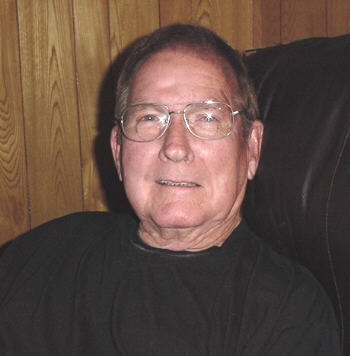|
JASPER E.
JENNINGS

Jasper Jennings was
born in Houston Co., TX; the son of Wade Jennings and Mona Ruth
Moffitt.
Jasper Jennings recounts his memories of
working at the Ice House, Crockett, Houston Co., TX as well as
other remembrances.
Information courtesy of:
Jasper & Kay Jennings
|
|
Sometime prior to 1949,
the Ice House in Crockett, Texas was owned by Texas Power &
Light. I believe that prior to TP&L owning the Ice House; they
generated electricity with coal as fuel at the location on East
Houston. Sometime prior to 1949 The Southland Corporation
purchased the facility from TP&L.
I believe that TP&L had stopped generating electricity sometime
prior to 1949 however they maintained an electrical distribution
system and/or measuring devices until sometime later.
The ice making capacity of the facility was 30 tons per 24 hour
day. This was accomplished by use of 1 brine tank. This tank
contained room for about 480- 300# capacity cans for making ice.
(24 cans per row x 20 rows) The temperature was maintained from
10-20* F. Anhydrous Ammonia was used for the refrigerant.
Shortly after the Southland Corporation purchased the Ice House,
capacity was increased to 60 tons per day. The Southland
Corporation purchased a used compressor from a hotel in Dallas
that was being demolished. The compressor was manufactured by
the Baker Company.
The brine solution was circulated around the cans by means of a
propeller similar to one on an outboard boat motor. The liquid
refrigerant was allowed to vaporize through critical orifices
thus removing heat from the brine solution. Enough salt content
was maintained in this solution to prevent freezing of the brine
down to 5* F.
I was hired out of the tomato patch by my uncle Alvis Thomas
when I was 18 years old. He was the manager of the Ice House
before I worked there and remained with them until the mid
1950’s.
My first job was from 7 PM to 6 AM, 7 nights a week. The job was
to remove ice from the brine tank by means of an electrical
driven hoist--two 300# cans at a time, move them to a slack tank
(which provided a means to thaw the ice from the can so the ice
would fall out of the can when I dumped it). After the ice was
released from the can, it was placed in a tray that dumped onto
2 wooden shuts that permitted the ice to slide into the storage
room. At that time there was no electrical control of flows
and/or temperatures. It was all done manually.
In the fall and spring when the demand for ice was low, my job
was to go to the Ice House to shut down the ammonia compressor
to prevent freezing of the brine solution.
I saw my uncle fire a guy for sitting down in the doorway on the
top level of the brine tanks. He told him that he was afraid
that he would get pneumonia from sitting in the cold draft.
Actually my Uncle Alvis always said that if you were sitting
down, then they didn’t need you.
Things I remember most about my work at the Ice House was:
1. How difficult it was to get a day off. ---- My uncle almost
fired me when I Took a day off to go apply for another job.
2. Falling into the slack tank head first requiring considerable
effort to get out without drowning.
3. The smell of mule droppings on Saturday afternoon and evening
as Farmers came into town to buy ice. One 300# block was $1.00.
4. Pay was only .58 an hour.
5. A pill was added to each can of water to help prevent ice
from cracking when it was removed from the tank. We called these
Anti-cracking pills.
6. I would go with my Uncle Tom to deliver ice and he would jump
out of the truck while it was still rolling (about 2-3 MPH) then
get behind
It to get the ice out of the back.
7. I delivered ice to all the five & dime stores and to all the
hospitals in town, N.L. Asher Shoe Store, Lake’s Dentistry
(upstairs at the corner of S. 4th St. and Houston Ave), Shivers
Hardware Store in the 600 block of Houston Ave, and the Home
Café at N. 4th & Houston Ave.
When I turned 21 years old, I realized that there was a road out
of town and I took it. I went to work for Monsanto, a chemical
manufacturing complex in Texas City, TX where I worked for 34
years. There I helped start up a hydrogen cyanide manufacturing
plant in 1952 and for the last 15 years, I was operations
supervisor in the complex where I had the responsibility of safe
operations of storage tanks that held 600,000# of hydrogen
cyanide. Today, there is no hydrogen cyanide stored at this
facility to my knowledge, due to the risks involved. I retired
in 1985 and moved back to my home place near Kennard.
My wife, Kay, and I own a ranch where we raise registered
Limousin cattle that we sell for FFA & 4-H show animals and
commercial breeding purposes. Due to my declining health, my
wife handles most all of the ranching duties on our ranch in
addition to working full time in the emergency medical services
field. |